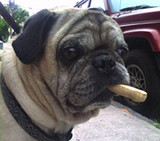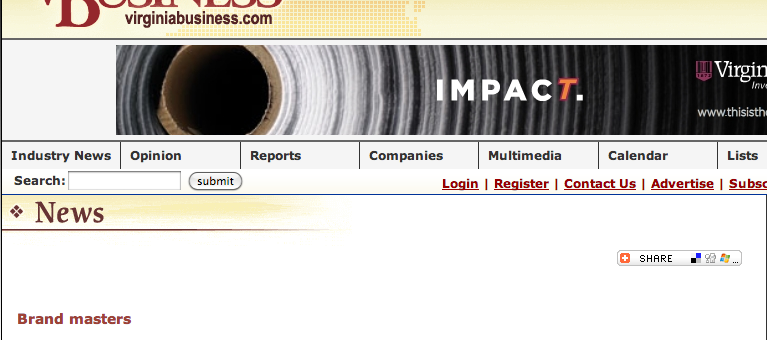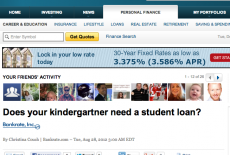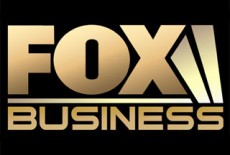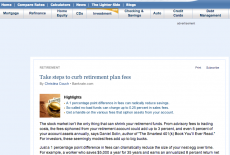Brand Masters
Cover story for the November 2007 issue of Virginia Business Magazine
When it comes to evolution, it’s hard to find a better example than Virginia’s Martin Agency. Like its quirkily contemporary Geico cavemen, the advertising firm sprang from primitive origins — a small shop doing mostly print work in a Southern city, far removed from the artistic chic of the East and West coasts. Yet over time Martin morphed into one of the country’s top-ranked agencies, producing breakout campaigns such as the Geico gecko and the UPS Brown ads.
Earlier this year, Martin proved it could compete with the best of them when it speared a prime catch: the $580 million account for Wal-Mart, the world’s largest retailer. More good news came in September when Mike Hughes, the agency’s president and creative director, got a telephone call from former Vice President Al Gore. The agency had yet another win, the $100 million-plus campaign for Gore’s nonprofit, the Alliance for Climate Protection.
A week later, Hughes was lunching with Gore in New York to plan campaign strategy. “At the end of the meeting, he leaned over and looked at me and said, ‘Mike, we cannot fail. The scientists who had been predicting that the Arctic ice caps will start melting in 50 years are now saying 20 years.’” Gore won the 2007 Nobel Peace Prize for his work in raising awareness about global warning, and his gravity wasn’t lost on Hughes. “Here I am, a guy who normally sells discount auto insurance, and now I’m working on the most important issue facing the world today.”
While Hughes pondered global warming, Martin creatives tuned in last month for the debut of “Cavemen” to see if ABC really could turn a 30-second commercial into a 30-minute show. The pilot evolved from Geico’s television spots featuring politically sensitive cavemen who took offense at the tagline about Geico.com being “so easy even a caveman could do it.” The initial show on Oct. 2 drew mixed reviews and raised questions on whether a commercial-turned-sitcom can survive the volatile environment of network television.
Martin’s staff of 400 works from a building in the heart of Richmond’s Shockoe Slip, a historic area of restored warehouses. The agency’s success, despite a low-key location, points to a larger industry trend: Geography doesn’t matter much anymore. In a wired universe, it doesn’t take a Madison Avenue address to do inventive work that makes a national mark.
As the communications landscape continues to shift from place-based to technology-based, other Virginia firms are snagging major accounts. For instance, CRT/tanaka in Richmond is the leading public relations and new media agency for Sprint Nextel Corp. Sprint spent $1.7 billion on ads in 2006, making it the 15th-largest marketer in the U.S.
In fact, as clients move beyond traditional media to target a larger audience, the trend bodes well for ad shops in midsize cities that, like Martin, aspire to do quality work. When Inc. magazine recently listed the fastest-growing private advertising and marketing firms in the U.S., nearly 80 percent of the companies were located outside of advertising’s traditional hot spots, such as New York, Chicago, Los Angeles, and San Francisco.
Still, taking a campaign from idea stage to pop culture status can be challenging when the view out the office window is one of cobblestone streets. “You have to work harder here to be in tune with what is most current in American culture,” says Martin’s Chairman and CEO John Adams.
Since its founding in 1965 by David N. Martin and George R. Woltz, the shop has made a conscious effort to do just that. Martin first gained national visibility in 1972 when it rolled out the popular “Virginia is For Lovers” campaign, the state’s best-known marketing effort. The agency prided itself on producing strong regional work as well as hiring bright talents, including Hughes and Harry Jacobs, a former Martin chairman who was inducted into the American Advertising Federation’s Hall of Fame in 2004.
By the 1990s, Martin was landing national and international accounts including Wrangler jeans, Mercedes-Benz and Saab. In 1995, it joined forces with Interpublic Group, a New York-based public conglomerate of communications agencies from around the world. Operating as a separate subsidiary, Martin generates about $64 million a year in revenue and has a small office in New York.
While its work has gained national notice since the 1980s, the last two years have cemented Martin’s reputation. The agency came in at No. 5 on this year’s A-List compiled by Advertising Age. And it’s racked up some impressive awards including Advertising Week’s Top Icon of the Year for the Geico gecko in 2006, an award the Geico cavemen are up for this year. Current clients include such heavy hitters as Seiko, The Learning Channel, Discover Card and ESPN’s X Games.
Martin’s creative flair shows that a location in the heart of American culture may be more strategic than one in the heart of the advertising community. Dean Jarrett, Martin’s senior vice president of marketing and communications, credits the agency’s Richmond address in helping it land accounts for all-American brands such as Wal-Mart and B.F. Goodrich. “We’ve had multiple clients say, ‘You live where most of America lives and you actually understand our consumer better than someone who rides the subway every day or who lives in a high-rise.’”
At an estimated $250 billion a year, advertising is a potent, persuasive force in the country’s economy. More companies, including Martin, are offering an integrated set of services under one roof, so they can better serve clients by branding and marketing projects over multiple platforms. The Geico cavemen’s evolutionary leap from the Stone Age to prime-time television is a perfect example of technology’s impact on this mission.
These urbane Neanderthals were first introduced in 2004 in a television spot. Their comedic indignation at the slogan about Geico’s Web site was almost immediately embraced by the public, particularly by bloggers. “The blogs were just going crazy,” says Steve Bassett, Martin’s senior vice president and a creative director, who recalled some of the chatter. “‘Did you see the caveman spot last night?’ ‘I wonder where they live.’ ‘I wonder if they’re married.’ ‘I wonder if there are cavewomen.’ ‘I wonder if one of them is Val Kilmer.’”
The blog buzz led to a faux interview on CNN. Then the caveman walked the red carpet at the Oscars. That was followed by a fashion spread in Maxim magazine featuring a well-groomed, bushy-browed Cro-Magnon sporting an argyle vest on a golf course and, finally, the offer from ABC to take the caveman from 30-second spots to a 30-minute show.
The agency has other possible television projects in the works, says Hughes. Plus, it’s expanding data analytics, a department devoted solely to tracking and optimizing the effectiveness of each campaign. “This is going to sound so hokey, but what keeps me up at night right now is my excitement about the possibilities for us,” says Hughes. “How can we fit enough hours in the day? … How can we do all these things?”
Some in the industry wonder whether The Martin Agency has taken on too much, particularly the brand transformation for Wal-Mart. The high-volume, low-price retailer is the largest company in America with $345 billion in sales during the last fiscal year. But this Goliath wouldn’t win any popularity contests. It’s been vilified for driving local mom- and pop- stores out of business, and union groups have complained for years about workers’ rights and wages. Just this summer the New Jersey Supreme Court ruled that a lawsuit claiming off-the-clock violations could proceed as a class action on behalf of nearly 80,000 current and former Wal-Mart employees.
Plus, 2007 has seen a slowdown in same-store sales, flattening the company’s share price. In a recent front-page story, the Wall Street Journal proclaimed the Wal-Mart era on the wane, with customers wanting better quality, fresher products and more personal service, as opposed to low prices.
In the court of public opinion, Wal-Mart is fighting back. It recently rolled out an expanded health-care plan for employees, And it started a new “green” environmental initiative, which includes a sustainability program for employees, the sale of only eco-friendly laundry detergent and energy-saving light bulbs. At its Web site, the company notes its status as one of the largest private employers in the U.S. (with 1.3 million store associates) and the biggest corporate cash contributor in 2006 with $270 million donated to communities nationwide.
Since getting the account, Martin has added more than 100 new employees. Its vision for Wal-Mart is simple: “Save money. Live better.” That’s the slogan on new television spots, which show a family going on vacation with the money saved by shopping at Wal-Mart. What Martin hopes to do is shift the focus to the retailer’s positive impact on the world, by tapping into the advantages of massive scale. According to Wal-Mart, 127 million people visit its 4,000 American stores every week.
“Making changes at Wal-Mart can affect the whole economy of the world,” says Hughes. “You’re talking in such huge terms. It creates so many jobs. It creates so many opportunities for people … I think there are opportunities for Wal-Mart to really connect with people in ways they haven’t.” As for the creative work on the account, Hughes says “we’ve really just scratched the surface.”
The Martin Agency isn’t the only Virginia firm connecting with national clients. Besides the Sprint Nextel account, another big catch for CRT/tanaka is the national rebranding and marketing campaign for the Council of Better Business Bureaus.
Even smaller firms are landing bigger and better accounts than they did a decade ago. “One of the reasons advertising does well in Virginia is that we have great schools, and the Web has taken away the borders,” says Michael S. Delpierre, managing partner for the Chantilly-based marketing and branding firm ImageWorks Studios. Founded in 1995, the 11-person firm boasts clients on both coasts as well as throughout Europe. It pulls down more than $1 million year in revenue, says Delpierre, thanks to custom-designed online webinars that walk new clients through future projects.
Another reason Virginia has fared well in the age of technology-driven advertising is the prestige of Virginia Commonwealth University’s Adcenter in Richmond. Ranked by Creativity Magazine as the top advertising school in the country, it draws young talent from around the world. Many students do internships and post-graduate careers with area firms.
A healthy dose of good old-fashioned innovation doesn’t hurt, either. Richmond is home to smaller, innovative companies that are aren’t afraid to try something new. Take, for example, Ravenchase Adventures, a fledgling scavenger hunt/adventure race company. Ravenchase provides interactive online and real-world mystery events centered on specific products. “People are saturated and inundated with print ads and radio ads and TV commercials, so we’re trying to push something that’s really different,” says Ravenchase CEO Joshua Czarda.
Taking the road less traveled can pay off for both the agency itself and the work it produces, as The Martin Agency has proved many times. Structurally, the top-to-bottom advertising megastore is actually guided by a sort of make-your-own-rules, punk rock mentality. Unlike most agencies that operate under the direction of a sole creative director, it has multiple creative leaders — 15 to be exact — all of whom spearhead their own campaigns and support the work of the other directors.
“That’s very unusual for an agency of our size, but it’s made a huge difference,” says Hughes. “It’s really empowered a whole generation to take on leadership roles.” The approach proved especially effective with the brand work for Geico. Currently The Martin Agency operates three separate campaigns for the company — the gecko, the cavemen and the “good news (I just saved a lot of money on my car insurance)” spots — each of which has its own distinct feel and use of humor.
Hughes credits the multi-pronged approach (and the agency’s attempt to bring levity to an otherwise humorless subject) as one of the factors behind Geico’s nearly 400 percent growth in revenue in the past seven years. “When we took over [14 years ago], the ads were so negative. ‘You’re going to get hurt.’ ‘You’re going to have an accident.’ ‘You need insurance.’ And it was really sort of scare tactics,” recalls Bassett.
“We wanted to lighten up the category, so we came up with the tagline ‘15 minutes can save you 15 percent.’” With a positive spin in place, former Martin Agency art director Ken Spera created a gecko character as a quirky way of letting consumers know that the company’s name was pronounced “GUY-ko,” not gecko. Like the cavemen, the green reptile has a following of its own. “We didn’t set out to create a phenomenon, but it just became one,” says Bassett. “A lot of ads you see are happy accidents, and this was one of them.”
These days, the company is shooting for more than happy accidents. Instead, says Hughes, it aims for “repeatable successes” that transcend mere effective advertising and become a larger part of American culture. “They will be ideas that consumers talk about, clients prosper from and the people who work here are proud of,” says Martin’s mission statement.
Whether the agency can pull off its magic with Wal-Mart remains to be seen.
Adams already has traveled to Dallas to spend time with 3,000 Wal-Mart store managers. Locally, its staff is “spending tons of time in Wal-Mart stores,” says Hughes. By the time it’s through, the Martin team is determined that the retailer will stand for more than a bland smiley face. Evolution at its best?

